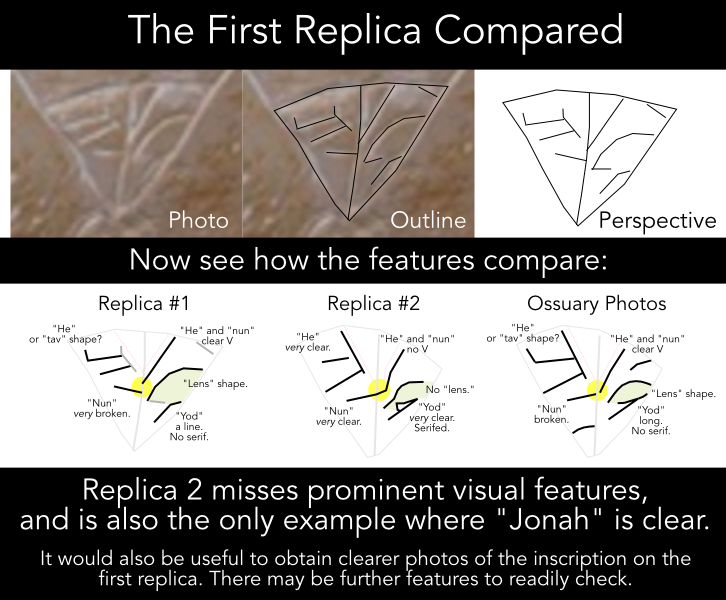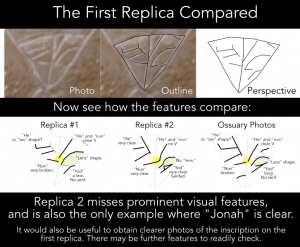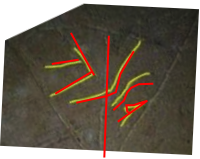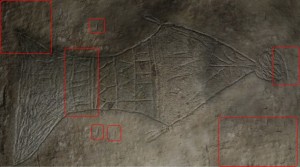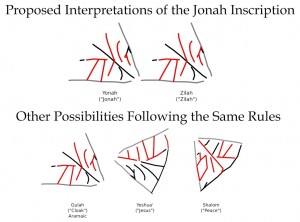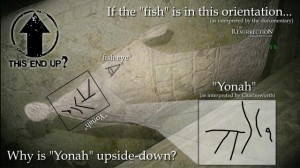The title of this article is what I believe is the biggest problem with the entire Talpiot debacle: The unfaithful representation of archeological evidence. Since I hope to be thorough enough in this article to make it my last post about the Jonah Ossuary for quite some time, allow me to start at the very beginning.
The “Fish”
 |
| The original page 42. |
Since the first press release of the Jonah Ossuary the multimedia was unfaithful. The very first shot of the “fish” that the public was given was simply described as a “blow up” (“A Preliminary Report” first version, p. 42).
 |
| The initial image released to the world. |
However it was not too long before it was discovered that this initial image was computer-generated composite that was rotated 90 degrees to the right. Digital manipulation artefacts and damnable evidence of reconstruction were found throughout the image, which included (among other things):
- Adding an additional line of ornamentation.
- Reconstructing an entire “fin” of the fish.
- Removal of borders.
- Stitching artefacts between frames that were of differing perspective.
- Cloning artefacts where details of the inscription were copied down in more than one place.
These criticisms eventually lead Dr. Tabor, at first, to re-orient label the image in his original report and re-label the caption as a “blow up” (“A Preliminary Report” second version, p. 42) without providing citation of any change, addendum or correction.
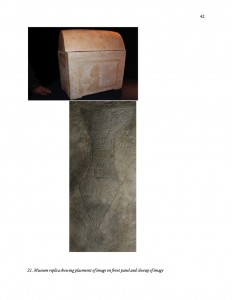 |
| The second revision. Note the caption and how the image was mirrored from the one above. |
The image in this caption was rotated back to it’s proper orientation, however it was mirrored horizontally to better match the image on the museum replica that was added above it.
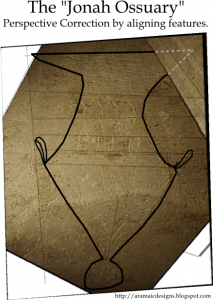 |
| This is no fish. |
With its original orientation confirmed, It was immediately recognized by the majority of commentators as a vessel, not a fish.
Very quickly after further mounting criticism, Dr. Tabor re-labeled the image once more to “CGI composite of image” (“A Preliminary Report” third version, p. 42), again not providing a citation of any change, addendum or correction.
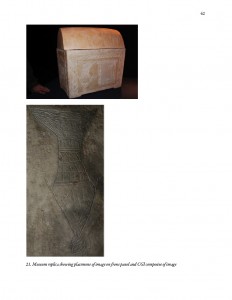 |
| The third revision. Note the drastic change in caption and the flipped image. |
He also mirrored the image horizontally again to bring it back to it’s original plane and orientation.
Throughout all of this, yet another image was featured at the very top of the Jesus Discovery website with the “fish” in yet another orientation.
 |
| And this version is still on their website. |
All of this re-labeling, flipping, rotating and resizing in response to criticism was alarming, especially since it was done in such a hasty manner. It was as if footprints were quickly being swept up to leave onlookers with no indication of a mistake or any acknowledgement of what has happened.
This is even worse when the CGI image itself was shown not to match actual photographs, and when actual photographs were examined, the figure began to look less and less like a fish, and more and more like a vessel (and vessels are relatively common on ossuaries from the time period).
Even the “museum quality replica” did not reproduce a number of features that were present on the CGI reconstruction such as what Tabor identifies as “Jonah’s head wrapped in seaweed.”
The replica rounds out the shape of the bottom of the figure — virtually eliminating its original shape — to make it more head-like, where the original is hemispherical, much like the base of contemporary pottery.
This artistic embellishment is not faithful to the original inscription.
If that were not enough, there were some additional oddities present on the replica that were not present on actual photographs of the inscription… or at least on photographs that were not digitally inked.
“Fish” in the Margins
On the museum replica, attention is drawn to “fish” in the margins of the ossuary’s border.
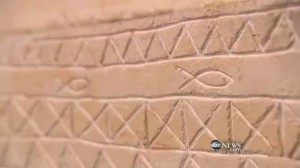 |
| Very obvious fish. Where are they on the original again? |
Images on The Jesus Discovery website originally showed these “fish in the margins” with digital ink over them to make them “clearer.” However, once criticism mounted, the original image was taken down from the website completely.
It was quickly replaced with:
- Image 60, which shows the original inscription
- Image 61, which has digital ink over the inscription to show “fish”
All of the images that do not have digital ink clearly show that the “fish” in the margins are ovals, not ichthoi, as the replica shows clearly.
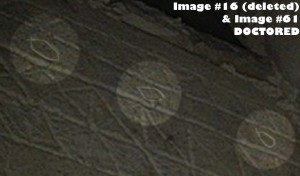 |
| Very weak “fish” with digital ink. |
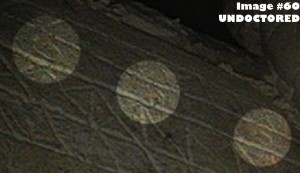 |
| No indication of fish. |
This framing is not faithful to the original inscription.
Filtered Images
On The Jesus Discovery’s website, digital ink was not the only tool used. Image filters were also employed.
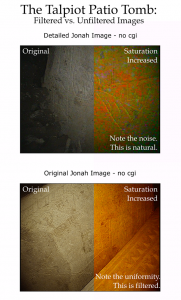 |
Note the difference in color and texture between these two “no cgi” images.
The latter is enhanced with a sepia filter, which reduces important contrast. |
Dr. Tabor was very adamant with his claims that none of the images were enhanced; however, the color and levels on a number of examples labeled “no cgi” prove otherwise.
“CGI” is an initialism which stands for “computer generated imagery.” Where Dr. Tabor may argue a point of nomenclature or technicality (perhaps stating that nothing was “constructed” in these images), a number of pictures labeled “no cgi” were raw where others were processed and enhanced by a computer with no distinction between the two.
This appears to make “no cgi” a label that is unfaithful to the state of the presented evidence.
The Jonah Inscription
Not soon after the documentary came out, “another discovery” was hinted to about the Jonah Ossuary that was “discovered” by Dr. James Charlesworth: That the very name of Jonah was found inscribed in the “mouth” of the “fish” itself.
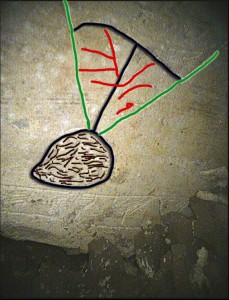 |
| As Charlesworth sees it. |
 |
| The text, isolated and rotated. |
Now, these outlines provided by Tabor and Charlesworth could very well spell out “Yonah” provided that they are a faithful representation of what is actually on the ossuary. However, that is once again the crux of the matter.
 |
Several of the “letters” aren’t quite connected.
Other lines must be ignored. |
There are serious problems with it, to the point that a large number of other scholars have been scratching their beards over how they reached this conclusion:
-
-
-
-
-
-
-
-
-
And the list is growing.
Each photograph of the inscription shows a slightly different set of lines, even accounting for things such as color enhancement and angle of light.
This has led multiple interpretations depending upon which lines are taken into account, and which lines are ignored, showing that the series of lines is more of a Rorschach than a hard and fast inscription.
However, despite these shortcomings, soon after this “discovery hit” Dr. Tabor then published a press release with the following image as the only frame of reference: [1]
This is an unfaithful representation of what is on the ossuary.
Conclusion
From the very beginning this entire “find” has been handled sloppily. Where robot arms and ephemeral claims to early Christianity are fascinating, they do not replace traditional excavation and cataloging.
Furthermore, timing releases to be in synchronization with the Easter season without any traditional peer review beforehand is extremely problematic. Choices to tell a good story and make sensationalist claims seem to have been made over choices to present the evidence properly, and the fingerprints of such decisions seem to be all there.
I firmly believe that if this tomb were to be traditionally excavated that the evidence would be very clear that we are not looking at an early Christian tomb with “fish” on an ossuary labeled “Jonah,” but something much more mundane.
It would be something that the world of Biblical Studies would appreciate, discuss, and even “geek-out” over (as an old tomb is always fascinating to those in the field); however, it would make very poor television.
Peace,
-Steve
—
[1] Apparently different press release sites selected different images.
